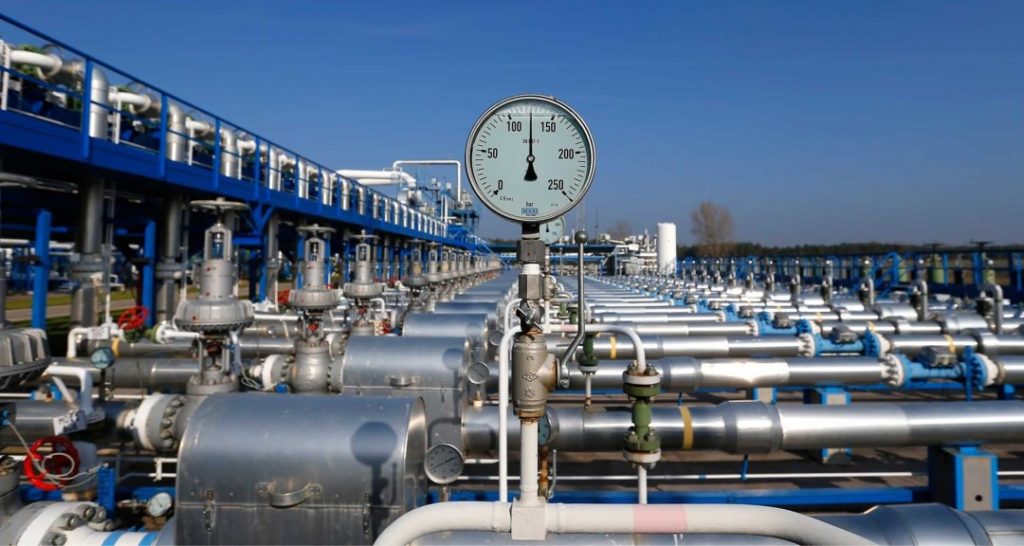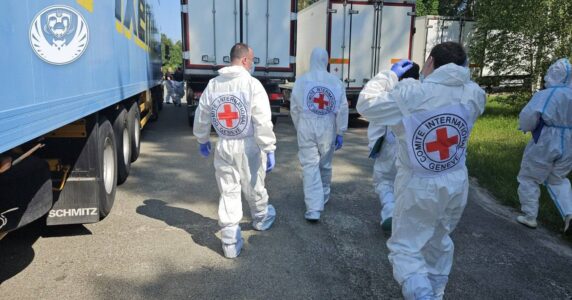Navigation and useful materials
Russian fakes about gas appear in Ukrainian news probably more often than information about the real state of affairs. Most of us are so used to hearing them that we don’t even question them, and the Kremlin successfully uses it against us.
Whereas real facts about who steals gas from whom or uses “dangerous American technology” may surprise you. Here are a few.
KREMLIN’S FAKE:
“Ukraine steals Russian gas.”
Behind the fake:
The message “Ukraine steals gas” began to appear in the Russian media back in the early 1990s, right after Ukraine gained independence. Russia used this categorical but false accusation to make both the Ukrainians and Ukraine’s international partners doubt the integrity of Ukraine. The Kremlin also used it during the 2008—2009 gas disputes.
Lack of evidence has not stopped the Kremlin from using the issue as a political weapon for the past 30 years. The goal is to undermine confidence in Ukraine and disrupt projects that strengthen its energy independence.
Actual facts:
After 2014, when Russia stole part of Ukrainian territory, it also illegally appropriated Ukrainian gas production in the Black Sea and in the occupied parts of Donetsk and Luhansk regions.
After occupying Crimea, in violation of the UN Convention on the Law of the Sea and the Law “On the Exclusive (Maritime) Economic Zone of Ukraine,” Russia illegally appropriated the Black Sea deposits.
According to available data, Russia extracts 1.6 billion m³ of gas on the Black Sea shelf annually. From 2014 to 2020, Russia extracted 12 billion m³ of gas from fields owned by Ukraine. On the territory of Donbas, Russia extracted about 200 million m³ per year, which is equal to the volume of Ukraine’s daily gas consumption during the winter period.
During the entire occupation of Crimea and parts of Donetsk and Luhansk regions, Russia has illegally appropriated and extracted over 13 billion m³ of gas, which is equal to the annual needs of the Ukrainian population.
KREMLIN’S FAKE:
“Ukraine has always depended and will depend on Russian gas.”
Behind the fake:
Ukraine has not always been a gas importer, as Russia is trying to show. Ukraine was the first of the Soviet republics to start extracting and exporting gas back in the 1920s.
After World War II, Ukraine was one of the suppliers of natural gas to the West, and the oil fields in Boryslav, Lviv region, were among the largest in Europe at the time. Later, the Dashavske and Oparske gas fields were discovered in Lviv region, from which the Soviet Union supplied gas to Poland after the war.
The Soviet Union used gas fields in Ukraine extensively. Yablunivske, Rudkivske, Shebelinske, Yefremovske, and Khrestyschenske deposit fields were discovered. As of 2019, according to the Ukrgazvydobuvannia report, those deposits were depleted by almost 80—90%.
Actual facts:
In 2013, Ukraine’s gas dependence on Russia was almost 90%. But since November 2015, Naftogaz has not purchased gas directly from Gazprom.
At the same time, the imported gas coming from Poland, Hungary and Slovakia is gas of Russian origin. This strengthens Russia, which is trying to enhance its geopolitical influence through its monopoly on the European energy market. That is why it is so important for Ukraine to provide itself with as much gas as possible from its own fields.
KREMLIN’S FAKE:
“Ukraine is preparing for shale gas extraction, which will lead to an environmental disaster.”
Behind the fake:
Russia’s hysteria over shale gas began in 2013-2015, when Royal Dutch Shell, under an agreement with Nadra Yuzivska, carried out prospecting and exploration for the production of energy resources in Yuzivska field, including gas from unconventional sources, in particular shale gas. Russia used the term “shale gas”, new to Ukraine, to spread disinformation about an allegedly dangerous technology of its extraction — hydraulic fracturing. In fact this technology is safe, widespread and used for extracting gas from traditional sources as well. In the world, in Ukraine and in Russia itself.
Local communists and dubious environmental organizations began to actively oppose a “dangerous extraction,” gathering rallies against it in Kramatorsk, Krasnoarmiisk, and other cities. The rallies were held under manipulative slogans like: “Paid for gasoline — paid for your own murder” (ignoring the fact that gasoline is made from oil and has nothing to do with gas production), “Stop sponsoring the destruction of nature,” and “Shale gas is a second Chernobyl.”
In January 2021, Naftogaz Ukraine and its subsidiary Ukrgazvydobuvannia announced the launch of development of the first tight gas field, Svyatohirskyi, located in Yuzivska area on the border of Donetsk and Kharkiv regions. And the Kremlin once again launched a disinformation campaign about an allegedly “dangerous” shale gas production in this area. Russian and then local media responded with intimidation: “Kyiv is preparing an environmental disaster in Donbas”, “Shale genocide unleashed”, “How Ukraine is turning Donbas into a desert”, etc. The goal is to prevent Ukraine from increasing its own gas production.
Actual facts:
Currently, Naftogaz does not extract and does not plan to extract shale gas in Yuzivska field. It is planned to produce ordinary, traditional gas in Yuzivska field, as is the case in more than 140 other fields throughout Ukraine. There are frozen or liquidated wells in the area that were previously drilled by other companies, and Naftogaz plans to restore them. You can read more about Naftogaz’s plans on the Nadra Yuzivska website.
There is no shale gas production in Ukraine at all. Given that it lies at great depths in dense rocks, its production is much more expensive compared to traditional natural gas. That is, it requires a lot of funds and investments and is even economically unfeasible for the country today.
KREMLIN’S FAKE:
“Ukraine will create an environmental disaster in Donetsk region by extracting gas using dangerous American technologies.”
Behind the fake:
This refers to a hydraulic fracturing technology. Despite the fact that Russia itself uses this technology, it actively disseminates the myth of “environmental disaster” to which the government-controlled areas of Donetsk region are allegedly exposed due to hydraulic fracturing.
Back in 2014, Russia officially stated that gas production under “American technologies” could negatively affect the ecology of Russia’s border areas and it even sent an оfficial letter to the Ukrainian party. Since then and up-till-now, Russian media persist in disseminating disinformation about the “devastating environmental effects associated with the hydraulic fracturing technology,” scaring people with an inevitable pollution of groundwater and destruction of the entire ecosystem. The goal is to induce local residents to disrupt gas production in the region and turn them against the Ukrainian state.
Actual facts:
Hydraulic fracturing (fracking) is a proven technology used to extract oil, natural gas, geothermal energy or water from subsurface geological formations.
It is quite common in the world. By 2015 the number of hydraulically fractured wells had grown to 300,000, making up 59% of the total natural gas output of the United States. About 14,000 horizontal wells are hydraulically fractured in Canada annually. In Ukraine, this technology has been used by various companies since 2016, and over the past 5 years, several hundred such operations have been conducted in different regions. In Russia, fracking is a common technique of gas extraction. In 2020, the number of hydraulic fracturing operations increased to 21,000, according to the Rosneft reports.
In fact, fracking is both a technically and environmentally safe technology provided that the appropriate standards and norms are met.
Fracturing technology is an injection of water-based fracturing fluid (over 99% water) to a great depth (which makes it impossible to interact with the horizons from which drinking water is taken) in the reservoir under high pressure. This creates microcracks in the rock, liquid penetrates them and literally pushes the hydrocarbons into the well. Due to the peculiarities of the geological structure of Ukrainian deposits, the solution for such operations contains only 0.5-1% of other impurities that are widely used in the food industry (for example, guar – a natural polymer obtained from plants of the legume family). And getting such a solution during the operation in aquifers or surface soils is technologically impossible – fracturing is used 3,000-5,000 meters deeper.
KREMLIN’S FAKE:
“Gas extraction in Ukraine will result in shallowing of wells, land and air pollution, deterioration of the drinking water quality, and forest destruction.”
Behind the fake:
Russia regularly launches this disinformation to undermine the development of Ukrainian gas production. In 2013 and 2021, it managed to provoke protests among local population.
Actual facts:
These fakes are regularly refuted by environmentalists, who say that gas extraction is quite safe provided that all regulations are observed.
Wells and water boreholes cannot shallow because of gas extraction because they are mostly at a depth of 10—150 meters, and the formations from which gas is extracted are at a depth of 3,000—5,000 meters.
Drilling causes no damage to the land because before drilling fertile topsoil is removed, collected and after the end of work is reclaimed and restored.
The statement that the ground can sink because of gas removal from underground cavities is also untrue. In fact, gas is contained in the micropore spaces of rocks that cannot physically sink.
With regard to deforestation, potential drilling sites are really selected in the forest area. In such cases, according to a Naftogaz report, an agreement is concluded with the forestry, under which the forestry shall prepare the sites for the construction of wells. This cooperation includes payment for planting trees to restore forest areas.
Definitely not. Disinformation is a powerful Russian weapon, and the gas topic is one of the key battlefields of hybrid warfare. Therefore, the issue of gas, its extraction and transportation is constantly attacked by Russian officials, politicians and media.
Moscow has long replaced a commercial component with a geopolitical one even in official documents. In the Еnergy Strategy of Russia for the period up to 2020 approved in 2003, the Kremlin openly recognizes energy resources and the fuel and energy sector as tools of Russia’s foreign and domestic policy, and in the Еnergy Strategy of Russia for the period up to 2030 the expansion of energy supplies to the world market is defined as one on the priorities of energy policy of the Russian Federation. Thus, Russia has enshrined its intentions to use gas and oil resources as a weapon and a means of blackmail to strengthen its status in the post-Soviet and European markets.
The construction of Nord Stream 2 in combination with disinformation attacks is a classic hybrid operation aimed at expanding the Kremlin’s influence on European countries, destabilizing Ukraine and steering it back into the Kremlin’s fold.
- Ukraine was estimated to possess natural gas reserves of 1.3 trillion m³. Based on current gas consumption of about 32 billion m³ of hydrocarbons each year, these reserves will be sufficient for more than 30 years.
- Currently, most — about 85% — of natural gas deposits are located in the eastern part of Ukraine. The western and southern ones account for the remaining gas deposits (10% and 5%, respectively). According to geologists, the largest deposits of natural gas are located in the Dnieper-Donetsk basin in Kharkiv and Poltava regions.
- Unleashing the natural gas resource base in Ukraine and, as a result, Ukraine’s independence from gas imports is provided for in the Naftogaz Group’s Strategy’2025.
- Obtaining the possibility of exploration and development of gas fields will increase the estimated gas production potential up to 600 billion cubic meters by 2025.
- Currently, Ukraine produces only 2/3 of gas needed for domestic consumption. But improvements in technologies that simplify gas production in “old” fields, discoveries of new deposits and attraction of the investments will help Ukraine increase its own production. And this is its energy independence.

If you have found a spelling error, please, notify us by selecting that text and pressing Ctrl+Enter.


